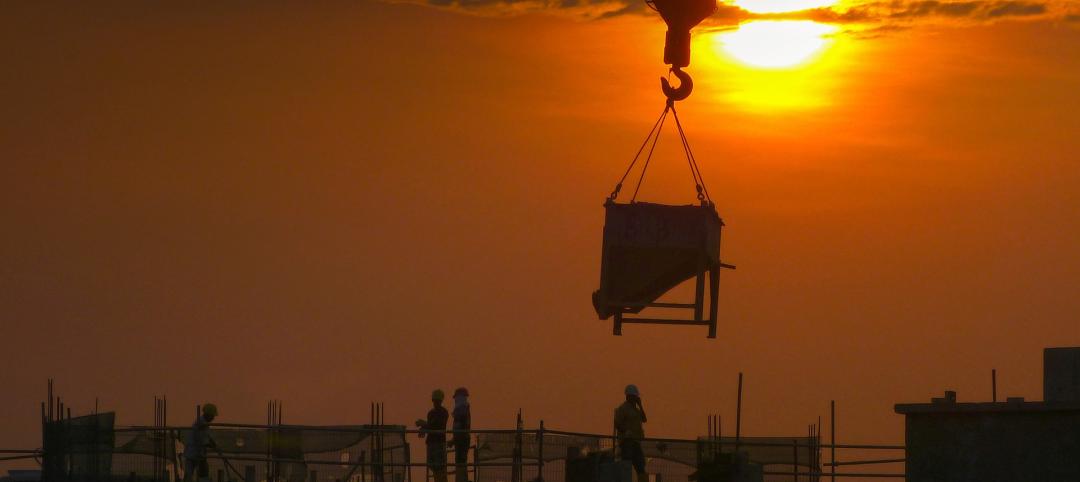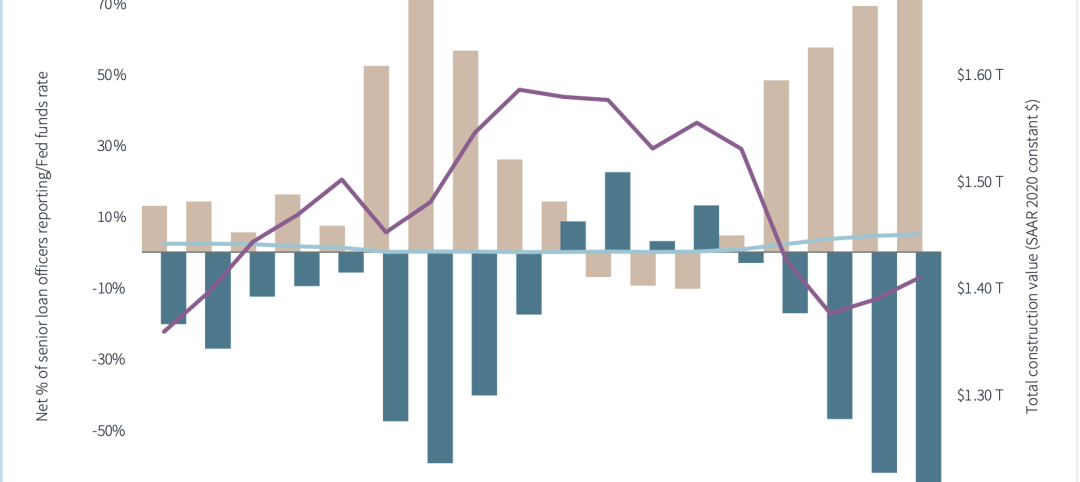The coronavirus has harmed the construction industry, prompting project delays and cancellations, layoffs and furloughs, yet it remains difficult for a majority of firms to find craft workers to hire, according to the results of a workforce survey conducted by the Associated General Contractors of America and Autodesk. The survey paints a picture of an industry in need of immediate recovery measures and longer-term workforce development support, association officials added.
“Few firms have survived unscathed from the pandemic amid widespread project delays and cancellations,” said Ken Simonson, the association’s chief economist. “Ironically, even as the pandemic undermines demand for construction services, it is reinforcing conditions that have historically made it hard for many firms to find qualified craft workers to hire.”
Sixty percent of responding firms report having at least one future project postponed or canceled because of the coronavirus, while 33% report having projects that were already underway halted because of the pandemic. The share of firms reporting canceled projects has nearly doubled since the survey AGC conducted in June, when 32% of respondents reported cancellations.
The coronavirus has also undermined the sector’s productivity levels as firms across the country change the way they operate to protect workers and the public from the disease. Forty-four percent of responding firms report that it has taken longer to complete projects and 32% say it has cost more to complete ongoing projects because of the coronavirus. As a result, 40% report they have adopted new hardware or software to alleviate labor shortages they have experienced.
“The results of the AGC and Autodesk workforce study reveal that the construction industry is still grappling with the changes and consequences of the coronavirus pandemic,” said Allison Scott, director of construction thought leadership and customer marketing at Autodesk. “The long-term effects of the current crisis have yet to play out, and firms that double down on innovation efforts, whether an increased focus on lean construction, workforce training or technology that facilitates remote collaboration will be well poised for enduring resilience.”
The coronavirus has also negatively affected many firms’ confidence in future demand for projects. Only 42% of firms report their volume of business has returned to year-ago levels or is expected to do so in the next six months, compared to 52% who held this view in AGC’s June survey. Another 37% expect returning to normal levels of business will take more than six months, while the remainder don’t know.
While the pandemic has led to project delays and cancellations nationwide, contractor expectations of recovery do vary by region. Forty-five percent of respondents in the Northeast expect it will take more than six months for their firm’s volume of business to return to normal, compared to only 34% of respondents in the West, 35% in the South, and 41% in the Midwest.
There are also some differences by project type and revenue size. For instance, highway and transportation contractors report the greatest difficulty in filling hourly craft positions, with nearly three out of four (73%) reporting an unfilled craft position on June 30. About two-thirds (69%) of utility infrastructure and federal and heavy construction firms had unfilled craft positions then, along with 58% of building construction firms.
Small firms were less likely to have experienced cancellations of upcoming projects. Fifty-six percent of firms with revenues of $50 million or less report a project has been postponed or canceled, compared with 71% of midsized firms (revenue between $50.1 million and $500 million) and 69% of large firms (revenue exceeding $500 million).
Roughly a third of responding firms furloughed or terminated employees as a result of the pandemic and shutdowns ordered by government officials or project owners. Most of those firms have asked at least some laid-off workers to return to work. But 44% of firms that recalled employees report that some have refused to return, citing a preference for unemployment benefits, virus concerns, or family responsibilities, among other reasons.
The pandemic has also made it difficult for many firms to fill open positions, especially for hourly craft jobs. A majority (52%) of respondents report having a hard time filling some or all hourly craft positions, especially openings for laborers, carpenters and equipment operators. Sixty percent of firms had at least one unfilled hourly craft position as of June 30. In addition, 28% of respondents report difficulty filling salaried positions—in particular, project managers and supervisors.
In addition to turning to diverse technologies to alleviate labor shortages, 38% of firms report having increased base pay rates to attract and retain workers. In contrast, only 3% of firms have reduced pay, in spite of the downturn in business.
Construction firms also identified a series of measures that Washington officials could take to help the industry. Fifty-five percent of responding firms, for example, said they were looking to Congress to increase funding for all forms of public infrastructure and facilities. Fifty-three percent of firms want Congress and the Trump administration to enact liability reforms to shield companies who are protecting workers from the coronavirus from needless lawsuits. And 41% want Congress to address unemployment benefits that serve as artificial barriers to returning people to work.
Association officials unveiled new plans to encourage more people to pursue high-paying careers in construction to ease hiring challenges and find a way to attract recently unemployed people into the construction industry. Among other steps, the association is launching a new “Construction is Essential” campaign to highlight the many benefits of construction careers.
“There is a lot that Washington officials can do to help boost demand for construction projects and get more people back to work rebuilding the economy,” said Stephen E. Sandherr, the association’s chief executive officer, noting the association was pushing Congress and the administration to enact new recovery measures. “The challenge is that the coronavirus has put many contractors in the position of looking for work and workers at the same time.”
The association and Autodesk conducted the Workforce Survey between August 4 and 26. Over 2000 firms completed the survey from a broad cross-section of the construction industry, including union and open shop firms of all sizes. The 2020 Workforce Survey is the association’s eighth annual workforce-related survey.
Click here for survey materials including national, regional and state fact sheets, survey analysis and event remarks.
Related Stories
Contractors | Sep 12, 2023
The average U.S. contractor has 9.2 months worth of construction work in the pipeline, as of August 2023
Associated Builders and Contractors' Construction Backlog Indicator declined to 9.2 months in August, down 0.1 month, according to an ABC member survey conducted from Aug. 21 to Sept. 6. The reading is 0.5 months above the August 2022 level.
Contractors | Sep 11, 2023
Construction industry skills shortage is contributing to project delays
Relatively few candidates looking for work in the construction industry have the necessary skills to do the job well, according to a survey of construction industry managers by the Associated General Contractors of America (AGC) and Autodesk.
Market Data | Sep 6, 2023
Far slower construction activity forecast in JLL’s Midyear update
The good news is that market data indicate total construction costs are leveling off.
Giants 400 | Sep 5, 2023
Top 80 Construction Management Firms for 2023
Alfa Tech, CBRE Group, Skyline Construction, Hill International, and JLL top the rankings of the nation's largest construction management (as agent) and program/project management firms for nonresidential buildings and multifamily housing work, as reported in Building Design+Construction's 2023 Giants 400 Report.
Giants 400 | Sep 5, 2023
Top 150 Contractors for 2023
Turner Construction, STO Building Group, DPR Construction, Whiting-Turner Contracting Co., and Clark Group head the ranking of the nation's largest general contractors, CM at risk firms, and design-builders for nonresidential buildings and multifamily buildings work, as reported in Building Design+Construction's 2023 Giants 400 Report.
Market Data | Sep 5, 2023
Nonresidential construction spending increased 0.1% in July 2023
National nonresidential construction spending grew 0.1% in July, according to an Associated Builders and Contractors analysis of data published today by the U.S. Census Bureau. On a seasonally adjusted annualized basis, nonresidential spending totaled $1.08 trillion and is up 16.5% year over year.
Giants 400 | Aug 31, 2023
Top 35 Engineering Architecture Firms for 2023
Jacobs, AECOM, Alfa Tech, Burns & McDonnell, and Ramboll top the rankings of the nation's largest engineering architecture (EA) firms for nonresidential buildings and multifamily buildings work, as reported in Building Design+Construction's 2023 Giants 400 Report.
Giants 400 | Aug 22, 2023
Top 115 Architecture Engineering Firms for 2023
Stantec, HDR, Page, HOK, and Arcadis North America top the rankings of the nation's largest architecture engineering (AE) firms for nonresidential building and multifamily housing work, as reported in Building Design+Construction's 2023 Giants 400 Report.
Giants 400 | Aug 22, 2023
2023 Giants 400 Report: Ranking the nation's largest architecture, engineering, and construction firms
A record 552 AEC firms submitted data for BD+C's 2023 Giants 400 Report. The final report includes 137 rankings across 25 building sectors and specialty categories.
Giants 400 | Aug 22, 2023
Top 175 Architecture Firms for 2023
Gensler, HKS, Perkins&Will, Corgan, and Perkins Eastman top the rankings of the nation's largest architecture firms for nonresidential building and multifamily housing work, as reported in Building Design+Construction's 2023 Giants 400 Report.

















